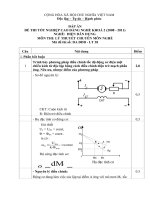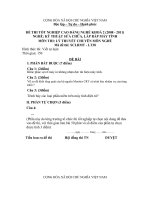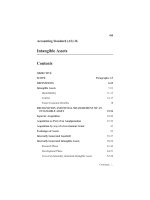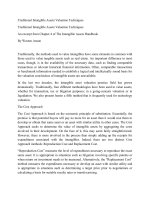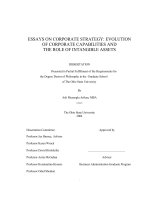IAS 38 intangible assets
Bạn đang xem bản rút gọn của tài liệu. Xem và tải ngay bản đầy đủ của tài liệu tại đây (529.83 KB, 40 trang )
IAS 38
INTANGIBLE ASSETS
Presented by :
March 8th, 2019
INTANGIBLE ASSETS
Objective and scope
Definition
Recognition and measurement
Acquired intangible assets
Internally generated intangibles
Measurement after recognition
Retirements and disposals
Disclosures
Objective and scope
Objective
Allow entities to Identify and Recognize separate value of intangible assets.
Enables users to Assess more Accurately the value and make up of assets of the entity
Objective and scope
Scope
Definition of intangible asset
Recognition and De-recognition as an asset
Determine carrying amount
Determination and treatment of impairment losses
Disclosure requirement
DEFINITION
Having future economic benefits
No physical substance
With high degree of uncertainly concerning the future benefit
Arises from the contractual and other legal rights
Clearly distinguishable and controllable
COMMON TYPE OF
INTANGIBLE ASSETS
Patent
Goodwill
Copyrights
Intangible assets
Trademarks
Franchises
Start-up
costs
Recognition
Recognition
An asset can recognize as an asset if
Flow of probable future economic benefit into the entity
Cost can be measured reliably
Acquired Intangible
Assets
Acquired separately
Purchase price, include import duties and non-refundable purchase taxes after deducting trade discounts
and debates
Directly attributable cost of preparing the asset for its intended use.
Acquired Intangible
Assets
Not include in cost:
o Advertising, promotional activities
o Training associated with new products, locations, customers
o Administrative and other general overhead
o Early stage operating losses
Acquired Intangible
Assets
Example 1
DAF Co purchased a quota for carbon emissions on 30 April,2017 in the following term:
List cost
$240,000
Import duty
$15,000
non-refundable
purchase taxes
$5,000
Training cost
$20,000
Delivery fees
$7,000
In addition to the above information:
DAF Co was granted a trade discount
of 10% on the initial list price of the
asset and a settlement discount of 5%
if payment for the intangible asset was
received within one month of
purchase.
DAF Co paid for the plant on 25 May
2017.
How should the above information be
accounted for in the financial
statements?
Acquired Intangible
Assets
Example 1
Solution:
List price $240,000 - trade discount (10%) (24,000) $216,000 .
Import duty =
$15,000
non-refundable purchase taxes=
$5,000
Delivery fees=
$7,000
Total amount to be capitalized at 30 April 2017
$243,000
In addition the settlement discount received of $10,800 ($216,000 x 5%) is to be shown as other
income in the income statement.
Acquired Intangible
Assets
Intangibles acquired in an asset exchange:
Cost = fair value (FV) of what is given up, UNLESS
(a)
Transaction does not have commercial substance, or
(b)
The FV of neither the asset given up or the asset acquired can be reliably measured
If (a) or (b), cost = carrying amount of asset(s) given up
Acquired Intangible
Assets
Commercial substance exists if:
(a)
Future cash flows (amount, timing, risk) of asset received differ from those of asset given up; or
(b)
Entity-specific value has changed; and
(c)
The difference in (a) or (b) is significant when compared to the FVs of the assets exchanged.
Acquired Intangible
Assets
Acquired in a business combination:
Cost is its FV
Identifiable intangibles are recognized separately from goodwill
Best FV is quoted market prices in an active market – if not available, other methods are used
Internally Generated
Intangibles
Two Phases
Research Phase:
No intangible assets arising from the research phase may be recognized
There is insufficient certainly that it will generate future economic benefits
Development Phase: Intangible assets arising from the development phase are recognized when the
entity meets those two recognition criteria.
Internally Generated
Intangibles
Cost cannot be capitalized
The costs relating to many internally generated intangible items cannot be capitalized and are expensed
as incurred
Research cost
Start-up cost
Training cost
Advertising and promotion etc
Internally Generated
Intangibles
Example 2:
DAF Inc. is a start-up enterprise, through the contacts of its owner, received a
confirmed order from a well known aircraft manufacturer to develop new designs
for ducting the washing machine of their aircraft. For this project, DAF Inc. needed
funds aggregating to $1.1 million. It was able to convince venture capitalists and
was able to obtain funding of $1.1 million from two K16409 venture capitalists.
Internally Generated
Intangibles
Example 2:
The expenditures DAF Inc. incurred in pursuance of its research and development project follow, in
chronological order:
Expense
Amount
Cost of developing the duct and
producing the test model
$180,000
Cost revising the ducting process
$150,000
salaries of the technicians
$270,000
Testing cost
$120,000
Cost of the conference to
introduction new product
$60,000
Net profit for the year was estimated to
equal $850,000
Internally Generated
Intangibles
Example 2:
What is the proper accounting treatment for the various costs incurred during
year?
Solution:
The costs that were incurred should be expensed. The total costs that should be
expensed = $180,000 + $150,000 + $270,000 + $120,000 = $720,000.
Note:
Conference costs of $80,000 would need to be expensed because they are
independent from the development process.
Measurement after
Recognition
2 types of measurement
Initial measurement
Subsequent measurement
Measurement after
Recognition
Initial measurement
On Initial Recognition an intangible asset is measured at Cost
Incase of internal project Research Expenditure and Development Expenditure should be separated
Project Research expenditure will be treated as Expense
Project Development expenditure will be treated at Cost
Measurement after
Recognition
Example 3
DAF plc started research work on a new product on the first day of its accounting period, 1 October, 2017.
Expenditure at the rate of $4,000 per quarter and continued until 1 June, 2018 from which date expenditure was
increased to $6,000 per quarter. On 31 August, 2018 the managers announced their confidence in the
profitability of the project that was still in the development stage on 31 Dec, 2018.
How much will be the capitalized value of research and development expenditure on DAF plc’s SFP as at 31 Dec,
2018?
Measurement after
Recognition
Example 3: Solution
Quarter
Expenditure rate
Value
Type
1 Oct, 2017 – 1 June, 2018
3
$4,000
$12,000
Expense
1 June, 2018 – 31 Aug,2018
1
$6,000
$6,000
Expense
31 Aug, 2018 – 31 Dec, 2018
1
$6,000
$6,000
Capitalize
Measurement after
Recognition
Subsequent measurement
In Subsequent measurement 2 models are used
Cost model
Revaluation model
Measurement after
Recognition
Cost model
Carrying amount= Cost – Accumulated Amortization – Impairment losses
Asset classified as held for sale are show at the Lower of Fair Value less Costs to sell and Carrying amount
